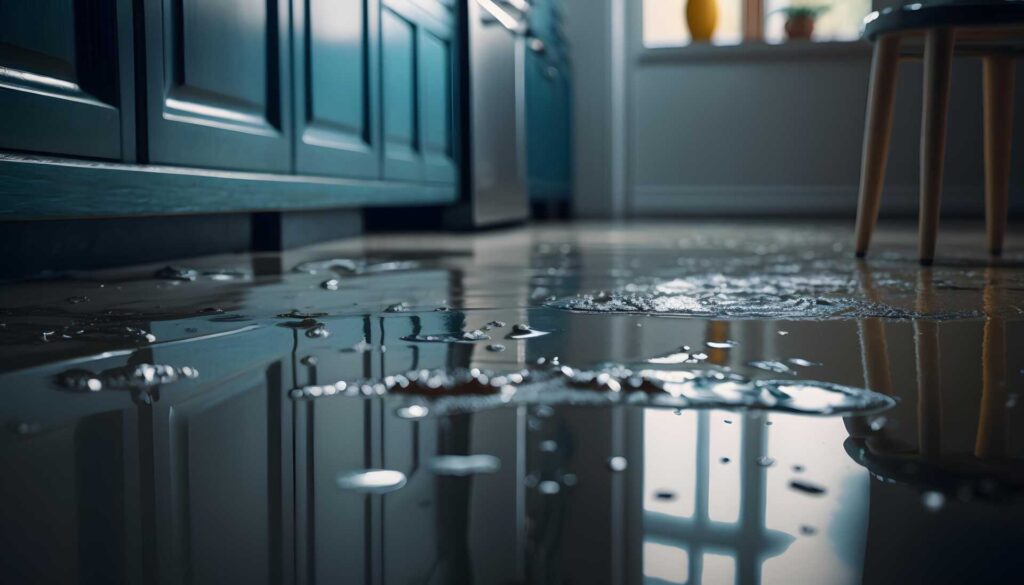
Contents
If you’ve ever experienced a burst pipe flooding your basement, you know the panic of dealing with sudden water damage. Imagine having a tool at your disposal to handle such emergencies swiftly and effectively. By mastering a few key DIY home water removal tips, you can be prepared for unexpected situations and potentially save yourself from costly repairs and headaches down the line. Keep reading to discover practical steps you can take to tackle water emergencies like a pro.
Key Takeaways
- Use wet vacuums for quick water extraction.
- Focus on hidden areas for thorough removal.
- Wear protective gear during the process.
- Work in sections to prevent water spread.
- Ensure proper ventilation for drying.
Assess the Water Damage
When it comes to DIY home water removal, the initial step is to thoroughly assess the extent of the water damage. Damage assessment is essential to determine the scope of the problem and plan your approach effectively. Start by identifying the water source that caused the damage. Is it from a burst pipe, a leaky roof, a malfunctioning appliance, or a natural disaster? Understanding the water source will help you address the root cause and prevent further damage.
Next, examine the affected areas in your home. Check for visible signs of water damage such as water stains, discoloration, warped surfaces, and mold growth. Use a moisture meter to detect hidden moisture within walls, ceilings, and floors. Take note of any areas where water has pooled or accumulated, as stagnant water can lead to structural issues and mold infestations.
Document the damage by taking photographs or videos for insurance purposes. Make a list of all the affected items and materials that may need to be repaired or replaced.
Prioritize removing water-damaged items to prevent further deterioration and mold growth. Remember to wear protective gear such as gloves, masks, and goggles when handling water-damaged materials to avoid health risks.
Stop the Source of Water
To effectively address water damage in your home, the first essential step is to promptly halt the source of water intrusion. This crucial step can prevent further damage and mitigate the impact on your property. Two key actions you can take are shutting off the water source and implementing leak prevention measures.
Stopping the Source of Water
| Action | Description | Benefit |
|---|---|---|
| Water Shut Off | Locate the main water shut-off valve in your home and turn it off to stop the flow of water into your property. | Prevents additional water from entering your home, minimizing damage. |
| Leak Prevention | Inspect plumbing fixtures, pipes, and appliances for any leaks or signs of water damage. Addressing leaks promptly can prevent further water intrusion and damage. | Avoids potential future water damage incidents, preserving your home’s integrity. |
| Monitor Water Usage | Keep an eye on your water bill for unexpected increases, which could indicate a hidden leak. Check water meter readings when no water is being used to detect any leaks early. | Early detection of leaks helps prevent extensive water damage and reduces repair costs. |
Remove Standing Water
Start by using a reliable common noun to assist you in removing standing water efficiently. Water extraction is a pivotal step in preventing further damage to your home. Here are three essential tips to help you effectively remove standing water:
Utilize Wet Vacuums: Wet vacuums are powerful tools designed specifically for water extraction. These vacuums can efficiently eliminate large volumes of water from various surfaces, such as carpets, floors, and upholstery. Make sure to use the appropriate attachment for the surface you’re working on to maximize efficiency.
Work in Sections: To ensure thorough water extraction, divide the affected area into smaller sections. Focus on one section at a time, using the wet vacuum to remove the water completely before moving on to the next section. This method helps prevent water from spreading to other areas and allows for more precise extraction.
Pay Attention to Hidden Areas: Standing water can seep into concealed or hard-to-reach areas such as corners, crevices, and under furniture. Be thorough in your extraction process and pay close attention to these areas to prevent moisture buildup and potential mold growth.
Dry Out Affected Areas
To effectively dry out affected areas after a water incident, it’s essential to employ dehumidifiers to control the moisture levels in the air. By reducing humidity, you can prevent mold growth and aid in the drying process.
Additionally, proper ventilation is vital to circulating air and expediting the evaporation of excess moisture, ultimately helping to restore your home to its pre-water damage condition.
Dehumidify for Moisture Control
Consider using a dehumidifier to efficiently manage moisture levels and speed up the drying process in areas impacted by water damage. Dehumidifiers are essential tools for restoring indoor spaces after water incidents.
Here are three key benefits of using a dehumidifier for moisture control:
Humidity Regulation: Dehumidifiers help maintain ideal humidity levels, preventing mold growth and safeguarding your home’s structural integrity.
Moisture Extraction: These devices effectively remove excess moisture from the air, carpets, and walls, assisting in the drying process and averting water damage escalation.
Air Quality Improvement: By eliminating excess moisture, dehumidifiers also aid in enhancing indoor air quality, reducing stale odors and potential respiratory issues linked to damp environments.
When addressing water damage, deploying a dehumidifier can greatly boost the overall drying process, minimize secondary damage, and create a healthier indoor environment. Be sure to position the dehumidifier in the most impacted areas to optimize its efficiency in combating moisture and facilitating a prompt recovery.
Ventilate to Aid Drying
When dealing with water damage, it’s significant to ventilate the affected areas to assist in the drying process effectively. Proper air circulation is pivotal for drying out damp spaces. Here are some key drying techniques to help you ventilate and dry out your home after water damage:
| Ventilation Tips | Description |
|---|---|
| Open Windows | Allow fresh air to flow in and assist in drying out the area. |
| Use Fans | Position fans strategically to circulate air and speed up drying. |
| Dehumidifiers | Help reduce moisture levels in the air, assisting the drying process. |
| Air Circulation | Ensure there is proper airflow throughout the affected area to prevent mold growth. |
Clean and Disinfect
To effectively clean and disinfect after water damage, it’s essential to thoroughly sanitize all affected surfaces to prevent the growth of harmful bacteria and mold.
Use proper cleaning techniques, such as disinfectants and cleaners specifically created for water damage restoration, to ensure a safe and healthy environment.
Disinfecting After Cleanup
Disinfecting after cleaning up water damage is an important step to ensure your home is safe and free from harmful bacteria. Proper sanitization and thorough cleaning can help prevent mold growth and provide a healthy environment for you and your family.
Here are three essential steps to effectively sanitize your home after water damage:
Use a Disinfectant Solution: After cleaning the affected areas with soap and water, apply a disinfectant solution to eliminate any remaining bacteria. Make sure to follow the instructions on the product label for proper usage.
Focus on High-Touch Surfaces: Pay special attention to frequently touched surfaces like doorknobs, light switches, countertops, and handles. These areas can harbor harmful bacteria and should be thoroughly disinfected to prevent the spread of germs.
Allow for Sufficient Drying Time: Ensure that the disinfected areas are completely dry before using them again. Proper ventilation and air circulation can help accelerate the drying process and prevent moisture-related issues.
Proper Cleaning Techniques
Implementing appropriate cleaning techniques is vital for effectively removing water damage from your home. When addressing water-damaged areas, it’s important to clean and disinfect thoroughly to prevent mold growth.
Begin by eliminating any standing water using a wet vacuum or mop. Next, cleanse the affected surfaces with a blend of water and mild detergent. For tougher stains and odors, consider using a blend of water and vinegar or a commercial cleaner recommended for the specific surface.
Proper ventilation is key during the cleaning process. Open windows and use fans to increase airflow and assist in drying out the area. This helps prevent moisture from lingering, which can contribute to mold growth.
Additionally, make sure that all surfaces are completely dry before proceeding with any repairs or restoration work. By following these cleaning techniques and promoting proper ventilation, you can effectively address water damage and minimize the risk of mold infestation in your home.
Preventing Mold Growth
To effectively prevent mold growth after water damage, thorough cleaning and disinfection are necessary. Mold prevention is essential to maintain a healthy living environment. Here are three key steps to help you clean and disinfect properly:
Remove visible mold: Use a combination of detergent and water to scrub off any mold growth on hard surfaces. Make sure to wear protective gear like gloves and a mask to avoid exposure to mold spores.
Disinfect affected areas: After cleaning, disinfect the surfaces with a solution of water and bleach (1 cup of bleach to 1 gallon of water). This will eliminate any remaining mold spores and prevent regrowth.
Control moisture: Proper moisture control is essential in preventing mold. Ensure that the affected area is thoroughly dried using dehumidifiers, fans, or opening windows for ventilation. Address any water leaks or sources of moisture promptly to prevent mold from thriving in damp conditions.
Monitor for Mold Growth
Keep a close watch on your home for any signs of mold growth following water removal. Mold can start to develop within 24-48 hours after water damage, so it’s vital to monitor your surroundings diligently. Noticing mold early can prevent further harm to your property and potential health risks to you and your family. Here are some tips to help you monitor for mold growth effectively:
| Signs of Mold Growth | What to Do |
|---|---|
| Musty Smell | Investigate the source |
| Visible Mold Patches | Clean with mold-specific products |
| Water Marks on Walls/Ceilings | Check for hidden mold |
| Increased Allergy Reactions | Consult with a professional |
If you detect any of these signs, it’s crucial to take action promptly. Mold can spread rapidly and cause structural damage if left untreated. When addressing mold growth, make sure to wear protective gear such as gloves and a mask to avoid exposure to spores. Cleaning visible mold with a mixture of water and detergent can help, but for extensive mold infestations, it’s advisable to seek professional assistance. Remember, early detection and treatment are vital to preventing mold from becoming a more significant issue in your home. By staying vigilant and taking proactive steps, you can effectively manage mold growth post-water damage.
Final Thoughts
So there you have it – DIY water removal tips to handle emergencies like a pro. Remember, being prepared is key to protecting your home from water damage. Stay vigilant, act quickly, and don’t underestimate the power of water. Who knew a little H2O could cause such chaos? But with these tips in your arsenal, you’ll be ready to tackle any water emergency that comes your way. Stay dry, my friends.
Recent Posts
What Are Eco-Friendly Water Damage Repair Methods?
When it comes to addressing water damage in an environmentally friendly manner, eco-conscious methods are
7 Best Eco-Friendly Water Damage Repair Methods
When faced with water damage, you must consider the environmental impact of your repair methods.
Sustainable Water Damage Repair Techniques: A How-To Guide
When faced with water damage in your home, it’s crucial to explore sustainable repair techniques
